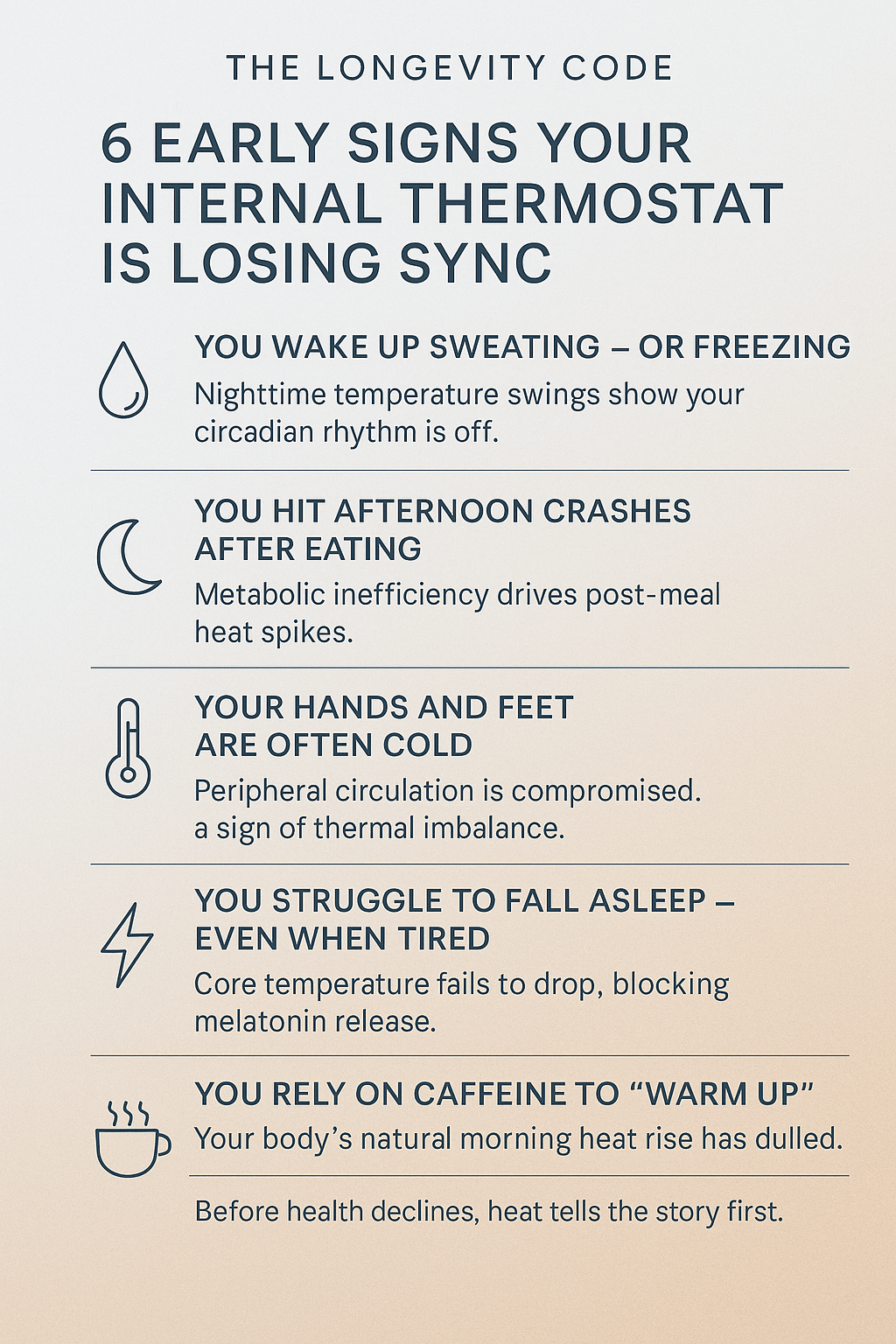- The Longevity Code
- Posts
- What the body knows about temperature
What the body knows about temperature
Every degree tells you something about energy, recovery, and aging
THIS WEEK’S CODE:
💡 The focus → Core body temperature quietly controls how fast you age.
⚠️ The impact → Chronic heat from inflammation and stress speeds up decline.
✅ The fix → Tune your thermostat with light, movement, and smart heat stress.
Read time: 5 minutes
If you’ve ever woken up groggy after a hot night or felt sharp after a cold morning walk, you’ve experienced how temperature runs the show.
Core body temperature is the quiet conductor behind energy, focus, and recovery.
It rises and falls in rhythm with your hormones, your sleep, and your metabolism, setting the pace for how young or old your body feels.
It fluctuates through the day - morning warmth from cortisol, evening cooling as melatonin knocks in. But as we age, or accumulate metabolic stress, that pattern begins to flatten. The “hidden dial” of temperature regulation drifts upward, and things start to slow down: recovery takes longer, energy dips, repair mechanisms tighten.
That subtle rise is more than a comfort issue; it’s one of the earliest biological signs that your body’s internal balance is starting to slip - here’s what you can do about it.

Why body temperature rises with age
Our internal thermostat, scientifically known as the hypothalamus, works constantly to keep internal organ temperature stable.
When it starts to degrade, the feedback loops weaken: cooling becomes less efficient, vasodilation and sweating responses turn sluggish.
Chronic low-grade inflammation (often called inflamm-aging) raises baseline tissue temperature, increasing demand on repair systems and shifting resources away from optimization.
Meanwhile, mitochondrial inefficiency (energy lost as heat instead of useful work) becomes more pronounced. This drives a higher “idle” body-heat level.

Moreover, modern observations show that metabolic rate is tightly linked to body temperature. In other words: higher baseline heat often reflects wasted energy and accelerated aging.
Interestingly, what counts as “normal” temperature is being reconsidered: the conventional 37 °C (98.6 °F) might not fully apply in a modern context of lower metabolic rates and reduced inflammation.
A rising internal temperature set-point is a subtle but powerful signal that your body’s repair/adaptation capacity is shifting away from optimization.
Biological connections: thermoregulation and resilience
Thermoregulation is the art of both generating and dissipating heat: vasoconstriction and thermogenesis raise body temperature, while sweating and vasodilation lower it.
When your system works well you have a broad dynamic range where you can ramp up when needed (exercise, challenge), and cool down efficiently (sleep, recovery). But when that range narrows, you lose resilience and the body remains stuck in a higher baseline, with fewer peaks and troughs.
A healthy dynamic range signals adaptability. It tells your system: you’re capable, you can deal with stressors and recover. That feedback loop is fundamental to longevity.
So the aim is not simply “keeping cool” or “avoiding heat” but rather expanding the range with the capacity to rise, to challenge, and then to fall back and restore.

Resetting your internal thermostat
1. Sync temperature with light-dark and environment
Morning light cues cortisol and gently raises body temperature in a healthy rhythm. Evening light reduction and a cooler bedroom temperature (e.g., ~18–19 °C) cue melatonin and cooling.
This aligns your thermoregulation with your circadian system, enhancing both sleep quality and repair.
2. Train thermoregulation through movement
Exercise creates a controlled rise in core temperature and forces your cooling systems to respond where over time, this strengthens your hypothalamic feedback and expands your temperature range.
Also consider deliberate cold exposure: cold plunges or cold showers act as hormetic stressors that boost metabolism, mitochondrial brown-fat activation, mood, and resilience.
For example: aim for 2-4 short sessions per week, 1-5 minutes each, in water cold enough that you’re “uncomfortable but safe”.
3. Introduce controlled heat exposure
Moderate heat exposure (like a sauna, hot bath) is still useful: it triggers heat shock proteins, improves vascular tone, and resets thermoregulation.
But it should be one pillar among several, not the entire strategy.
(Fun quiz here to find out which sauna may be right for your space from our friends at Heavenly Heat.)
After heat exposure, contrast (cooling afterwards) enhances the adaptation effect.
4. Metabolic and nutritional support
Your metabolic engine produces heat. If it’s inefficient (insulin resistance, mitochondrial dysfunction), you’ll waste energy as heat. Good nutrition, stable glucose control, and metabolic support will reduce unnecessary heat production and improve efficiency.
Focus on nutrient-dense whole foods, consistent meal timing, efficient movement, and sleep.
5. Monitor and fine-tune
Track your resting temperature, ideally early morning, after waking, and at thermoneutral state. Note your temperature variability (how much it falls overnight vs how it rises during the day).
A lower sustained baseline + healthy oscillation = a good sign.
A deeper signal
Your temperature is a language that your cells use to gauge readiness, repair, and resilience.
Training your body to learn how to fluctuate while rising when challenged and cooling when it’s time to repair helps everything from cognition to immunity.
The focus isn’t on keeping your body warm or cold. The focus is on keeping it responsive, knowing when and how to warm up or cool down based on both internal and external environmental factors.
So when your internal temperature drifts off rhythm, the cost isn’t just feeling sluggish, it’s losing the signal that keeps your entire system in tune.

TLDR TRIO
📈 Enhanced thermoregulation, improved metabolic efficiency, lower chronic heat burden.
✅ Better sleep, more stable daily energy, and less unnoticed wear-and-tear.
⌛ Align light & darkness daily; use 1-2 deliberate heat/cool sessions per week; expect visible improvement in 4-6 weeks.
